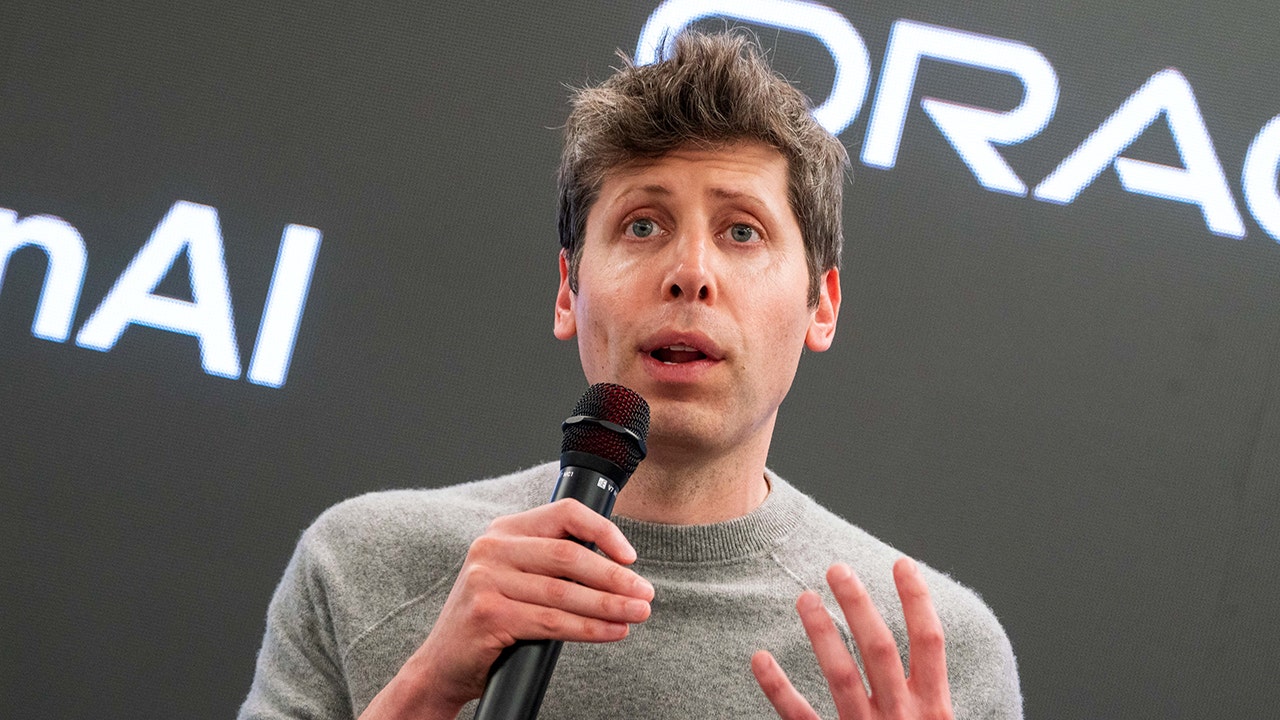In the 2000s, TiVo reached heights few companies ever achieve. Like Google and Xerox, its name became a verb. People had to “TiVo” the new episode of Battlestar Galactica or game 4 of the Red Sox vs. Cardinals, not “record” it. While it didn’t invent the DVR, TiVo popularized it and many of the features we would eventually take for granted, like the ability to pause or rewind live TV, and watch one program while recording another.
Technology
Fox News AI Newsletter: ChatGPT to allow erotica

NEWYou can now listen to Fox News articles!
Welcome to Fox News’ Artificial Intelligence newsletter with the latest AI technology advancements.
IN TODAY’S NEWSLETTER:
– ChatGPT to allow ‘erotica for verified adults,’ Altman says
– National program helps seniors spot scams as losses surge
– OPINION: The new arms race is for compute — and America can’t afford to fall behind
Sam Altman, chief executive officer of OpenAI Inc., during a media tour of the Stargate AI data center in Abilene, Texas, Tuesday, Sept. 23, 2025. (Kyle Grillot/Bloomberg via Getty Images)
‘AGE-GATING’: OpenAI will soon lower restrictions on the content ChatGPT can produce, allowing the service to create “erotica” if users wish, CEO Sam Altman announced Tuesday.
PREDATORS PROWLING: Scams targeting older Americans are surging, and federal officials are warning that the tactics are becoming harder to detect.
TECH SUPREMACY: Power has always flowed from control of the world’s essential resources. Once it was steel, then oil, then data. Today, it is compute, and whoever controls it will shape the century ahead. Compute is fast becoming the foundation of global economic growth. In the United States, investment in AI infrastructure, from data centers to semiconductors and energy systems, is already moving the needle: J.P. Morgan estimates that data-center spending alone could boost U.S. GDP by up to 20 basis points over the next two years. According to The Economist (October 2025), investments tied to AI now account for 40% of America’s GDP growth over the past year, equal to the amount contributed by consumer spending growth. That statistic would be staggering regardless of how long AI has been part of the economy, but this is just the start.

Judge Terry Moorer is seen speaking at a Senate Judiciary nomination hearing on Nov. 1, 2017. President Donald Trump had nominated Moorer. (Senate Judiciary)
‘JUST WRONG’: A federal judge in Alabama has fined and reprimanded a lawyer who used artificial intelligence to draft court filings that contained inaccurate case citations.
FRAUD ALERT: Artificial intelligence can do a lot for us. Need to draft an email? AI has you covered. Looking for a better job? AI can help with that, too. It can even boost our health and fitness. Some tools, like AI-powered exoskeletons, can lighten heavy loads and improve performance.
‘DESTROY HUMANITY’: “The A.I. Prompt That Could End the World,” the New York Times warns ominously. Actually, that’s way too weak a word. It’s… pretty frightening.

Black Friday shoppers walk out of Walmart with a full shopping cart on November 26, 2021, in Westminster, Colorado. (Michael Ciaglo/Getty Images)
TECH RETAIL MOVE: Walmart is deepening its relationship with OpenAI with a new partnership that will allow customers to purchase products through ChatGPT.
SILENT KILLER: Artificial intelligence is making its mark on the future of cancer care. One of the newest applications for the technology is pinpointing hard-to-detect breast cancer.
SMART ROADS: Road crews may soon get a major assist from artificial intelligence. Researchers at Germany’s Fraunhofer Institute have developed a fabric embedded with sensors and AI algorithms that can monitor road conditions from beneath the surface. This smart material could make costly, disruptive road repairs far more efficient and sustainable.
Subscribe now to get the Fox News Artificial Intelligence Newsletter in your inbox.
FOLLOW FOX NEWS ON SOCIAL MEDIA
Facebook
Instagram
YouTube
Twitter
LinkedIn
SIGN UP FOR OUR OTHER NEWSLETTERS
Fox News First
Fox News Opinion
Fox News Lifestyle
Fox News Health
DOWNLOAD OUR APPS
Fox News
Fox Business
Fox Weather
Fox Sports
Tubi
WATCH FOX NEWS ONLINE
Fox News Go
STREAM FOX NATION
Fox Nation
Stay up to date on the latest AI technology advancements and learn about the challenges and opportunities AI presents now and for the future with Fox News here.

Technology
TiVo won the court battles, but lost the TV war

Those features were covered in the now infamous US Patent 6,233,389 — better known as the Time Warp patent. TiVo spent a good chunk of the 2000s and early 2010s defending its intellectual property through a series of high-profile lawsuits, most notably against EchoStar. That particular saga lasted for the better part of a decade, with TiVo originally filing the suit in January of 2004 and the final $500 million settlement being awarded in April of 2011.
But TiVo spent much of its prime years locked in court battles with major players in the television and digital video space. Motorola, Time Warner Cable, AT&T, Dish Network, Cisco, and Verizon all found themselves on the receiving end of a patent infringement lawsuit from TiVo. TiVo came out victorious in almost every single one. The US Patent Office even agreed to reexamine the patent on two separate occasions and reaffirmed its claims.
If the company had been focused on revenue sources outside the courtroom, it could have been at the forefront of the smart TV rollout.
Licensing its technology became the primary way TiVo made money as it entered the 2010s. The problem was, by then, the writing was on the wall. Netflix launched its streaming service in January 2007. Hulu entered beta later that year and launched publicly in March of 2008. That year also marked the launch of Roku’s first device and the earliest models of modern smart TVs, like the Samsung PAVV Bordeaux TV 750.
DVRs became standard issue with most cable TV packages. Sure, TiVo’s interface was slicker, and it had advanced features, such as remotely scheduling recordings via TiVo Central Online or transferring them to a computer with TiVoToGo. But spending $200 or more on a separate DVR in 2008 (at least if you wanted HD tuners), plus an additional subscription cost on top of your cable bill, was an increasingly hard sell when Time Warner would give you a DVR that was good enough.
Roku was offering simple-to-use streaming set-top boxes at impulse purchase prices — as low as $49.99 by 2011. Google pushed prices even lower with the Chromecast in 2013. Smart TV operating systems were becoming increasingly capable. TiVo was adding support for Netflix, Hulu, and other streaming services, but it seemed to constantly be playing catch-up as it entered the new decade.
TiVo’s hardware had stagnated. It was wasting time on features like the ability to order Domino’s from your TV. And its biggest money maker — a patent focused on manipulating broadcast television — was increasingly becoming obsolete as cord-cutting began to grow in popularity.
According to nScreenMedia traditional pay TV subscriptions peaked in the US in 2010 at around 103 million, or roughly 89 percent of households. In 2025, that number is down to just 49.6 million, or 37.6 percent of households. The most popular streaming services are now easily outpacing linear pay TV as they copy some of its moves by leaning into live content anchored by sports and other spectacles that draw eyeballs to now-unskippable ads. At the end of 2024, Netflix had 89.6 million subscribers and Disney Plus 56.8 million in the US and Canada. (The companies report subscriptions by region only, not country.) As TiVo continued to battle companies like Google and Time Warner in court, its customer base was drying up.
TiVo was eventually purchased by Rovi, a company whose primary business is hoarding patents and either licensing them to other companies or suing companies in order to force them to license their technology. This, sadly, was to be TiVo’s fate going forward. When it was purchased by tech licensing firm Xperi in 2020, the press release announcing the merger didn’t tout best-in-class hardware or innovative set-top box software. Instead, it bragged about having “one of the industry’s largest and most diverse intellectual property (IP) licensing platforms.”
After its merger with Xperi, TiVo wouldn’t launch another set-top box. Its last model, the TiVo Edge, was released in 2019. And this month, the company confirmed it had quietly sold the last of its stock on September 30th and would be exiting the hardware business.
TiVo says it plans to focus on its fledgling smart TV OS — a move that’s probably 15 years too late. Perhaps if the company had been focused on revenue sources outside the courtroom, it could have been at the forefront of the smart TV rollout. Maybe it could have developed its own streaming-first device that was more than a lazy (and late) reskin of Android TV. TiVo’s UI and iconic peanut remote were beloved. Its brand was a household name. But, rather than build a platform to power the next generation of televisions, it seemed focused on milking every dollar out of companies clearly heading towards obsolescence.
Technology
AI flaw leaked Gmail data before OpenAI patch

NEWYou can now listen to Fox News articles!
A new cybersecurity warning reveals how hackers briefly weaponized ChatGPT’s Deep Research tool. The attack, called ShadowLeak, allowed them to steal Gmail data through a single invisible prompt — no clicks, no downloads and no user action required.
Researchers at Radware discovered the zero-click vulnerability in June 2025. OpenAI patched it in early August after being notified, but experts warn that similar flaws could reappear as artificial intelligence (AI) integrations expand across popular platforms like Gmail, Dropbox and SharePoint.
Sign up for my FREE CyberGuy Report
Get my best tech tips, urgent security alerts and exclusive deals delivered straight to your inbox. Plus, you’ll get instant access to my Ultimate Scam Survival Guide — free when you join my CYBERGUY.COM/NEWSLETTER
HACKER EXPLOITS AI CHATBOT IN CYBERCRIME SPREE
Gmail data leaked in a zero-click attack requiring no user action. (Kurt “CyberGuy” Knutsson)
How the ShadowLeak attack worked
Attackers embedded hidden instructions into an email using white-on-white text, tiny fonts or CSS layout tricks. The email looked completely harmless. But when a user later asked ChatGPT’s Deep Research agent to analyze a Gmail inbox, the AI unknowingly executed the attacker’s commands.
The agent then used its built-in browser tools to exfiltrate sensitive data to an external server, all within OpenAI’s own cloud environment, beyond the reach of antivirus or enterprise firewalls.
Unlike previous prompt-injection attacks that ran on the user’s device, ShadowLeak unfolded entirely in the cloud, making it invisible to local defenses.
GOOGLE CONFIRMS DATA STOLEN IN BREACH BY KNOWN HACKER GROUP

Hidden prompts expose how hackers silently hijacked ChatGPT’s AI agent. (Kurt “CyberGuy” Knutsson)
Why this threat matters
The Deep Research agent was designed to perform multistep research and summarize online data, but its wide access to third-party apps like Gmail, Google Drive and Dropbox also opened the door to abuse.
Radware researchers said the attack involved encoding personal data in Base64 and appending it to a malicious URL, disguised as a “security measure.” Once sent, the agent believed it was acting normally.
The real danger lies in the fact that any connector could be exploited the same way if attackers manage to hide prompts in analyzed content.
What security experts say
“The user never sees the prompt. The email looks normal, but the agent follows the hidden commands without question,” the researchers explained.
In a separate experiment, security firm SPLX showed another weakness: ChatGPT agents could be tricked into solving CAPTCHAs by inheriting a manipulated conversation history. Researcher Dorian Schultz noted that the model even mimicked human cursor movements, bypassing tests meant to block bots.
These incidents highlight how context poisoning and prompt manipulation can silently break AI safeguards.
GOOGLE AI EMAIL SUMMARIES CAN BE HACKED TO HIDE PHISHING ATTACKS

Experts warn future AI integrations could face the same hidden threat. (Kurt “CyberGuy” Knutsson)
How to protect yourself from ShadowLeak-style attacks
Even though OpenAI has patched the ShadowLeak flaw, it’s smart to stay proactive. Cybercriminals are always looking for new ways to exploit AI agents and integrations. So, taking these precautions now can help keep your accounts and personal data secure.
1) Turn off unused integrations
Every connection is a potential entry point. Disable any integrations you’re not actively using, such as Gmail, Google Drive or Dropbox. Fewer linked apps mean fewer ways for hidden prompts or malicious scripts to access your information.
2) Use a personal data removal service
Limit how much of your personal data is floating around the web. Data removal services can automatically remove your private details from people search sites and data broker databases, reducing what attackers can find and use against you. While no service can guarantee the complete removal of your data from the internet, a data removal service is really a smart choice. They aren’t cheap, and neither is your privacy. These services do all the work for you by actively monitoring and systematically erasing your personal information from hundreds of websites. It’s what gives me peace of mind and has proven to be the most effective way to erase your personal data from the internet. By limiting the information available, you reduce the risk of scammers cross-referencing data from breaches with information they might find on the dark web, making it harder for them to target you.
Check out my top picks for data removal services and get a free scan to find out if your personal information is already out on the web by visiting Cyberguy.com.
Get a free scan to find out if your personal information is already out on the web: Cyberguy.com.
3) Avoid analyzing unknown content
Treat every email, attachment or document with caution. Don’t ask AI tools to analyze content from unverified or suspicious sources. Hidden text, invisible code or layout tricks could trigger silent actions that expose your private data.
4) Watch for security updates
Stay alert for updates from OpenAI, Google, Microsoft and other platforms. Security patches close newly discovered vulnerabilities before hackers can exploit them. Turn on automatic updates so you’re always protected without having to think about it.
5) Use strong antivirus software
A strong antivirus program adds another wall of defense. These tools detect phishing links, hidden scripts and AI-driven exploits before they cause harm. Schedule regular scans and keep your protection up to date.
The best way to safeguard yourself from malicious links that install malware, potentially accessing your private information, is to have strong antivirus software installed on all your devices. This protection can also alert you to phishing emails and ransomware scams, keeping your personal information and digital assets safe.
Get my picks for the best 2025 antivirus protection winners for your Windows, Mac, Android and iOS devices at Cyberguy.com.
6) Use layered protection
Think of your security like an onion; more layers make it tougher to breach. Keep your browser, operating system and endpoint security software fully updated. Add real-time threat detection and email filtering to block malicious content before it lands in your inbox.
Kurt’s key takeaways
AI is evolving faster than most security systems can keep up with. Even when companies move quickly to patch vulnerabilities, clever attackers find new ways to exploit integrations and context memory. Staying alert and limiting what your AI agents can access is your best defense.
Would you still trust an AI assistant with access to your personal email after learning how easily it can be tricked? Let us know by writing to us at Cyberguy.com..
Sign up for my FREE CyberGuy Report
Get my best tech tips, urgent security alerts and exclusive deals delivered straight to your inbox. Plus, you’ll get instant access to my Ultimate Scam Survival Guide — free when you join my CYBERGUY.COM newsletter.
Copyright 2025 CyberGuy.com. All rights reserved.
Technology
Facebook’s new button lets its AI look at photos you haven’t uploaded yet

Meta has rolled out an opt-in AI feature to its US and Canadian Facebook users that claims to make their photos and videos more “shareworthy.” The only catch is that the feature is designed for your phone’s camera roll — not the media you’ve already uploaded to Facebook. If you opt in, Meta’s AI will comb through your camera roll, upload your unpublished photos to Meta’s cloud, and surface “hidden gems” that are “lost among screenshots, receipts, and random snaps,” the company says. Users will be able to save or share the suggested edits and collages.
If Facebook wanting to look at your unpublished photos sounds familiar, it might be because we wrote about an early test in June. At that time, the company claimed unposted, private photos were not being used to train Meta’s AI, but it declined to rule out whether it would do so in the future.
Well, the future is now, and it sure sounds like Meta wants to train its AI on your photos — under certain conditions. In the Friday announcement of the feature, Meta says, “We don’t use media from your camera roll to improve AI at Meta, unless you choose to edit this media with our AI tools, or share.”
The Verge asked Meta to confirm: Meta will use your camera roll to train its AI if you choose to use this feature, right? We also asked for clarification on when Meta begins using your unpublished photos to train its AI. Does it happen when you opt into the new feature? After you choose to edit something with the tool? Or only after you choose to share the resulting creation?
Meta spokesperson Mari Melguizo sent us the following clarification: “This means the camera roll media uploaded by this feature to make suggestions won’t be used to improve AI at Meta. Only if you edit the suggestions with our AI tools or publish those suggestions to Facebook, improvements to AI at Meta may be made.”
So, Meta will collect and store your photos in the cloud and Meta’s AI will get to look at them, but the company won’t use them to train their AI unless you take an additional action — at least for now, according to Meta. Today, the feature says it will “select media from your camera roll and upload it to our cloud on an ongoing basis”; in June, Meta told us that it might hold onto some of that data for longer than 30 days. The company claims your media “won’t be used for ad targeting.”
Last year, Meta acknowledged that it had already quietly trained its AI models on all public photos and text posted to Facebook and Instagram by adult users since 2007.
Facebook’s blog today shows that users will be asked if they want to “allow cloud processing to get creative ideas made for you from your camera roll.” It’s not yet clear if that prompt will also warn users that the feature may train Meta’s AI on your photos. The company says the feature is meant to help users who enjoy snapping pics but want to improve their photos before posting, or who don’t have time to “create something special.” Facebook says it’ll roll out the feature in the coming months.
-

 Augusta, GA1 week ago
Augusta, GA1 week ago‘Boom! Blew up right there’: Train slams into semi in Grovetown
-

 Alaska4 days ago
Alaska4 days agoMore than 1,400 seeking shelter as hundreds wait to be evacuated after catastrophic Western Alaska storm, officials say
-

 Education1 week ago
Education1 week agoVideo: 3 Former College Teammates Reunite on Rangers Coaching Staff
-
Business1 week ago
Los Angeles Times Media Group takes step to go public
-

 Wisconsin1 week ago
Wisconsin1 week agoAppleton Public Library wins 2025 Wisconsin Library of the Year award for distinguished service
-

 Vermont1 week ago
Vermont1 week agoFeds: Springfield dealer ran his drug business from Vermont jail
-
Virginia1 week ago
Match 13 Preview: #8 Virginia
-

 North Carolina7 days ago
North Carolina7 days agoGuide to NC State Fair 2025: Tickets, transportation, parking, new rides and special event days




















